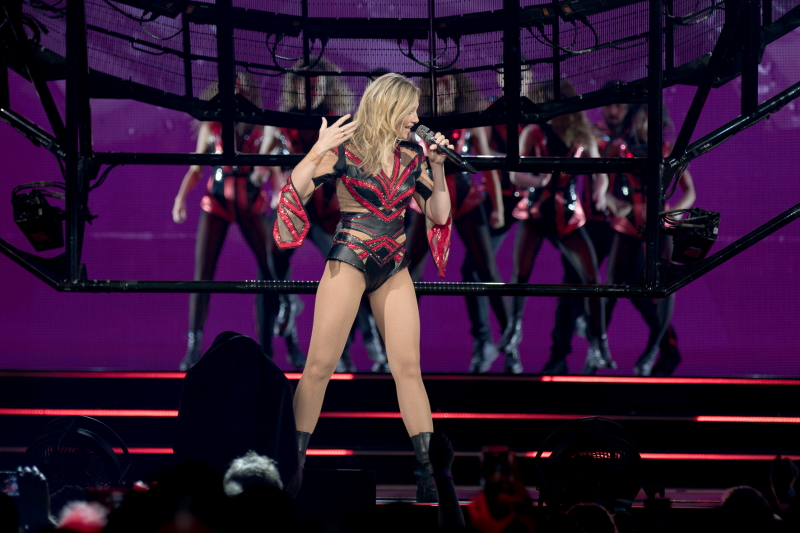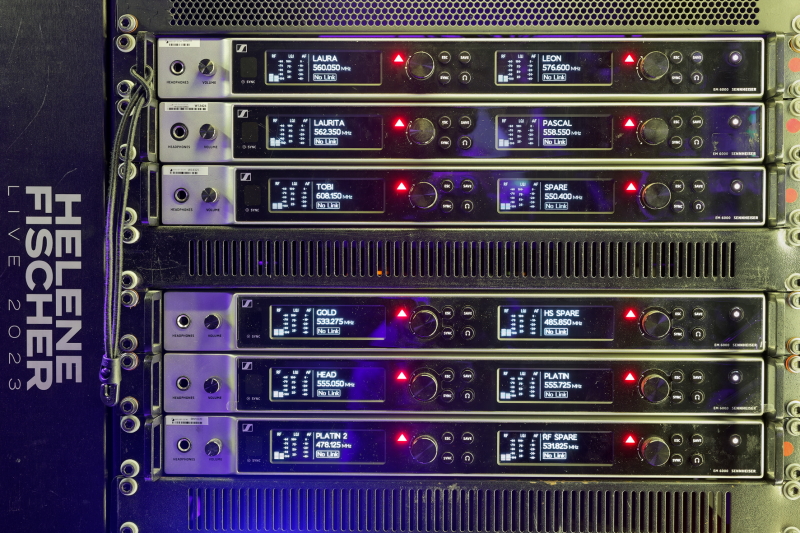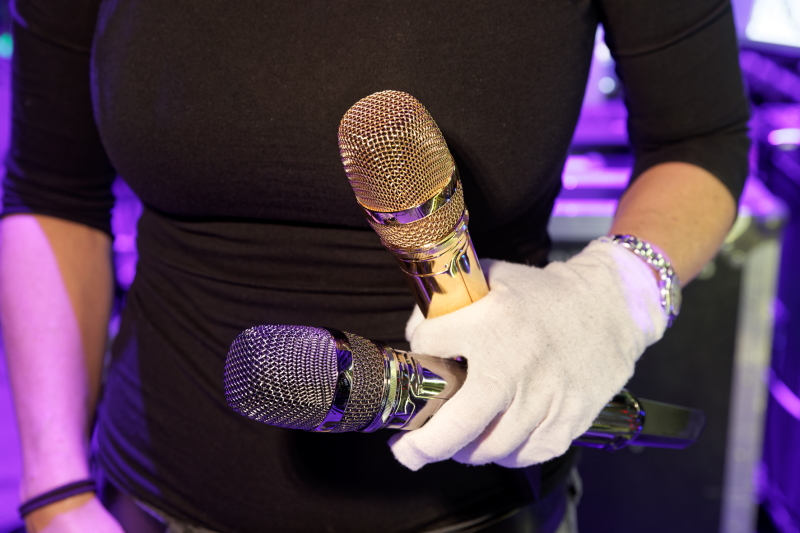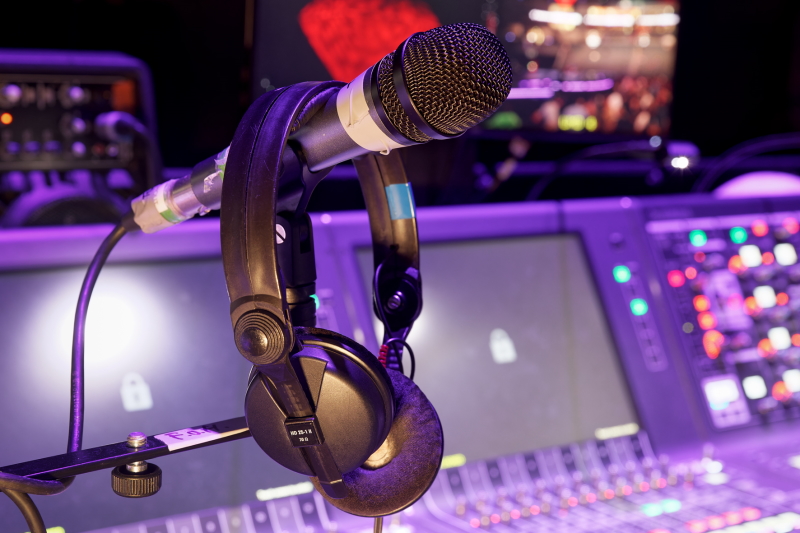Helene Fischer with Sennheiser Digital 6000

Fans of Helene Fischer will have to wait until 2026 before they can see and hear Germany’s most successful entertainer on her next round of stadium concerts – so it’s time to take a look back at her highly successful “Rausch” tour. In Cologne, the show to accompany her latest album was staged at the LANXESS arena seven times in a row – and it included some breathtaking acrobatics with a team of artists from Cirque du Soleil. Wireless microphones from Sennheiser’s Digital 6000 series made sure that Helene Fischer’s voice and all the backing vocals could be heard in excellent audio quality. Helene Fischer alternated between three custom-made Sennheiser SKM 6000 handheld transmitters in different looks: one gold- and two platinum-coloured models provided exciting light reflections on the stage. All handheld transmitters were equipped with MMK 965-1 true condenser microphone capsules.
For her acrobatic performances during the show, Helene Fischer used a headset microphone connected to the ultra-compact Sennheiser SK 6212 bodypack transmitter. This lightweight mini-bodypack is water- and sweat-resistant and can operate for up to 12 hours. A second headset/mini-bodypack combination was available as a backup and was assigned to a separate channel.
Five more vocals (three bvox, one guit, and a keys) were miked with the SKM 6000; a sixth handheld transmitter was kept in reserve as a safety back-up and was available as a separate channel on the mixing consoles. The transmitters were equipped with cardioid MM 435 dynamic microphone capsules, ensuring vocal clarity even in the high-volume live environment. The transmitters communicated in the A1-A4 (Helene Fischer, 470-558 MHz) and A5-A8 (backing vocals, 550-638 MHz) frequency ranges with a total of six Sennheiser EM 6000 two-channel receivers, whose features include excellent spectral efficiency due to their equidistant frequency grid, true bit diversity and a link quality indicator.

On the “Rausch” tour, the Sennheiser Wireless Systems Manager provided all the important information for operating the wireless systems at a glance. For the battery packs, two Sennheiser L 6000 charging stations were available, each with their own slots in the rack, and these were also connected to the Wireless Systems Manager.
Svenja Dunkel is one of the most renowned experts in the use of wireless systems for live events. But perhaps what is less well-known is that she is also a performer herself with many years of experience in the circus, and one who passionately combines her performances with drums and percussion.
As a multi-talented artist with an ideal background, Dunkel is a perfect fit for the inner circle of Helene Fischer’s crew. She is familiar with the challenges of acrobatic show elements from her own experience, and she knows what is important – including, of course, the best way to wear the microphone and the in-ear bodypacks. Outsiders often underestimate this aspect and fail to consider what might happen if the artists wrap their arms around each other during their performances and cover the antennas. Beltpacks can also get in the way during acrobatic tricks, and nobody should get tangled up in microphone cables or in-ear cables. It goes without saying that the fasteners and pockets for the beltpacks need to do their job reliably when Helene Fischer is floating upside down at dizzying heights. And it’s also obvious that water as a show element does not go together well with electronic systems, and direct contact needs to be avoided wherever possible. “Providing support for wireless systems doesn’t stop when the artist has been miked – it needs to take the artist’s entire performance into consideration,” says Dunkel.
Dunkel has been working for Helene Fischer regularly for many years now. However, the term “frequency manager” only describes a small part of her job. During Helene Fischer’s shows, Dunkel literally “has her hands full”. And she often wears a soft white glove to carefully protect Helene Fischer’s custom-made handheld transmitters, which have housings with a light gold or much darker platinum finish that has been applied by a jewellery manufacturer using a highly skilled craftsmanship process. “Rhodium black is the correct name”, Svenja Dunkel points out, adding that Helene Fischer has been performing with the Sennheiser Digital 6000 series since as long ago as 2017/18.
“Thomas Holz, who is our direct contact partner at Sennheiser, took responsibility for the special versions of the SKM 6000 handheld transmitters,” Dunkel reports. “I asked him to have at least two of each version made, as the handheld transmitters are exposed to extreme stress during Helene’s performances. We have water, fire and wind machines in the show. And, of course, hard-working dancers tend to sweat a lot. Something can always happen, so it’s good to have a replacement ready if the need arises. Another problem is that the handheld transmitter, with the platinum finish in particular, is not very easy to deal with. For example, I can’t use alcohol to clean it as this would damage the coating. So I usually use a soft cotton glove and occasionally a few drops of baby oil. In the course of a tour, however, it’s almost inevitable that its appearance will suffer a little, especially as Helene wears rings when she performs. It simply wouldn’t be possible to have only one handheld transmitter for a tour that lasts five months. We go on tour with two gold-coloured SKM 6000 and three with a platinum look.”

For her acrobatic performances, Helene Fischer uses resin on her hands for a better grip, and this is an additional stress factor for the housings of the handheld transmitters: “The resin sticks like crazy!” Dunkel says. “In Helene’s shows, there’s an extreme amount of action on stage, and everything is 100 percent live. When we consider all the various stress factors involved, I can only say that the Sennheiser equipment performs remarkably well in view of such huge challenges!” And it's not just the handheld transmitters that have a lot to put up with at Helene Fischer's shows – the compact SK 6212 bodypack transmitters are no different.
“Helene’s concerts are a kind of ‘performance-circus-live-rock’n’roll-pop’ show,” Dunkel adds with a smile. “The evenings are quite long and include a 30-minute interval while a mobile stage is set up in the centre of the arena. The shows begin on time at 8 p.m. and ends at around 11.15 p.m. Although the battery packs can easily survive this amount of time without any problems, I always replace them on Helene’s handheld transmitters during the interval to be on the safe side and I always carry a spare battery in my pocket. This isn’t really necessary, but it does give me a feeling of security. The battery packs for the Sennheiser SK 6212 bodypack transmitters are not replaced during the show.”
Holger Wild has been a regular member of Helene Fischer’s team for 17 years and has witnessed her meteoric rise almost from the very beginning. On the “Rausch” tour, Holger Wild was responsible for the monitor mix from a digital console without additional outboard equipment, while his colleague Alex Spengler at the FOH console used external 19” preamps to process Helene Fischer’s voice. “My motto has always been: Keep it simple!” says Holger Wild.
To convey the audience’s reactions to the performers on stage, Wild used two Sennheiser MKH 416 shotgun models as ambience microphones, which he placed about four metres above the floor. “Basically, I use these microphones to try to simulate Helene’s ears,” Wild explains. “I deliberately place the MKH 416 quite a distance from the audience, because if someone is standing near the microphone and starts applauding enthusiastically or, in the worst case, even whistles very loud, it would sound quite unpleasant if the distance was too short. Ultimately, my aim is to make the sound the same for Helene as it would be if she didn’t have plugs in her ears. I make sure that she always knows exactly what’s going on in the audience, and, of course, I continually adapt the ambience portion of the mix to what’s going on in the auditorium.”
Wild has this to say about the MMK 965-1 true condenser capsule: “Helene has been using the MMK 965 for a really long time now. She has got completely used to it and has developed a great microphone technique for her handheld transmitter. In the meantime, we experimented with some other capsules but, in the end, we always came back to the MMK 965.” ?
Wild uses a set of Sennheiser HD 25-1 II closed-design headphones to monitor the sound at his console, which is surprising because many monitor mixers use the same in-ear headphones as those used by the artist they are working with. “My approach is that a monitor mix has to sound good on every system,” he says. “After all, the people on the stage work with completely different headphones, and when you mix a music production in the sound studio, you have to make sure that it works when you’re listening either on a car radio or on an expensive hi-fi system. With my Sennheiser HD 25-1 II, I have a fantastic mobile monitoring device that I’ve have had for years and have got to know down to the finest details. Yes, I’m really impressed by these headphones!”

When asked to summarise his philosophy for working at the monitoring console, Wild says: “It’s no use if a single channel sounds fantastic but the mix as a whole doesn’t work. If you listen more closely to the individual channels in my mix, they might not sound that great on their own, but in the overall picture they work perfectly! I used to spend a lot of time tinkering around with the mix, but in the meantime I’ve come to the conclusion that you just have to let it flow and find its own level. The mix has to have a life of its own, otherwise it just becomes clinical and is no longer what I would call a good sound.” On the “Rausch” tour, Wild was supported by Jürgen Erhard at a second monitoring console.
Thomas Holz, Sennheiser Relationship Manager: “During the tour, I spoke with Helene Fischer and her manager Uwe Kanthak, and we discovered that Helene has been touring with Sennheiser wireless microphones for more than 15 years. The Sennheiser SKM 2000 handheld transmitters that she used to work with – including the custom-made light and dark models that were adorned with thousands of Swarovski crystals – are now in their well-deserved retirement, as are the 2000 series handheld transmitters with an electroplated gold and platinum finish. However, throughout all these years, Helene has remained loyal to the large-diaphragm Sennheiser MMK 965 true condenser capsule. Personally, I believe that the MMK 965 harmonises perfectly with Helene’s voice, and looking back over 15 highly successful years, I think you can rely on the old saying: “Never change a winning team!”
The “Rausch” tour was one more milestone in Helene Fischer’s illustrious career, which has certainly seen plenty of highlights. The title – which means ‘intoxication’ or even ‘exhilaration’ – was a perfect reflection of the Cologne performances. The shows were overflowing with energy, but were planned down to the finest detail and the staging was flawless, sending a rush of emotion throughout the audience. Exhilaration guaranteed.
Helene Fischer’s shows are well-known for providing world-class entertainment, and the concerts of the “Rausch” tour were no exception. In keeping with the opening number “Null auf 100” (Zero to 100), the audience was treated to “100 percent Helene”. The show got off to a flying start and never slowed down. Even in complex arrangements, the singer’s voice was always able to assert itself in all its nuances and dynamic variations, and the microphone’s excellent intelligibility ensured that the lyrics could always be clearly understood. All this was due not only to the achievements of the expert sound team, but also without doubt to Sennheiser’s pioneering wireless technology from the Digital 6000 series.
 How to resolve AdBlock issue?
How to resolve AdBlock issue?